Pasteur - The History of a Mind, a perspective
Author: M. Crasnier-Mednansky, Ph.D., D.Sc.Copyright © 2005 Mednansky Institute, Inc.
Pasteur - The History of a Mind was written by Emile Duclaux (1840-1904) and published in France one year after Pasteur's death in 1895. Emile Duclaux followed the teachings of Pasteur, entered his laboratory as his assistant, was later his collaborator and actively participated in the founding of the Pasteur Institute. As his readers we are indebted to him for achieving the difficult task of giving posterity the most accurate genesis of Pasteur's discoveries.
![But a mind...is a bird on the wing... [from the author's preface] Pages of Pasteur, The history of a Mind by Emile Duclaux](images/pasteur.jpg)
"Someone will say: How is it possible to make the history of a mind? …a mind, especially that of a scientific man, is a bird on the wing; we see it only when it alights, or when it takes flight. When it is the mind of a genius, like Pasteur, the difficulty seems almost insoluble. We may, by watching closely, keep it in view, and point out just where it touches the earth. But why does it alight here and not there? Why has it taken this direction and not that in its flight towards new discovery? If it were possible for you to know this and tell us, Pasteur will no longer be a genius, escaping analysis; and if you do not tell us, you will merely draw up a report, not write a history."
All this is true, and nevertheless I have written this book - Emile Duclaux
Pasteur's rare gift was his vision of the world, which he transformed by demolishing dogmas, stamping out erroneous views and fiercely imposing his own insightful ideas. At least the reader of Pasteur - The History of a Mind can grasp Pasteur's intuitive imagination and extraordinary skill for experimentation. The reader can further apprehend the genius in Pasteur by evaluating the colossal advancement in biological knowledge resulting from his studies on crystals, lactic and alcoholic fermentation, spontaneous generations, wines and vinegars, diseases of silkworms, manufacture of beer, etiology of microbial diseases, and vaccines.
In the early years of his life as chemist, while doing research on the left-right molecular asymmetry and its mode of action on polarized light, Pasteur was introduced to the realm of life. A living fermentative organism became a 'laboratory of dissymmetrical forces' and, as Pasteur soon discovered, could differentiate between the left- and right-handed activities of a molecule, and utilize one form without touching the other. Thus the young savant naturally approached the question of fermentations and later spontaneous generations.
At the time Pasteur initiated his studies on fermentations there was confusion of ideas, a multitude of arguments, and it was largely accepted that yeast was not involved in fermentation. Carried by the knowledge gained during the course of his studies on asymmetry, Pasteur immediately considered fermentation as 'a vital act'. A series of brilliant experiments followed leading Pasteur to discover the reproduction of 'ferments' (cells in Pasteur's view were the ferments), the effect of acidity on fermentation, the use of antiseptics to separate ferments, the products of fermentation and finally the division between aerobic and anaerobic life. Now Pasteur could no longer believe in spontaneous generations, as it denied the notion of specificity he had just introduced with his studies on fermentation.
The debate on spontaneous generations was misled by experiments lacking reproducibility. Pasteur, who had ingeniously defined a clear medium to study his ferments, was ready to tackle the issue. Results from experimentation confirmed his previous belief, and thus the partisans of spontaneous generations were given correct reasons for their experimental failure. Thereafter heated debates occurred in front of committees named by the Academy of Science and, despite the fact that some experimental results were given improper explanations, the recognition of the 'germ theory' prevailed. From this resulted safe conditions in conducting experiments by the introduction of autoclaves, as well as techniques such as sterilization by flaming.
Swan-neck flask used by Pasteur in his study of spontaneous generation, the flask exposed to the fall of atmospheric dust becomes clouded in two or three days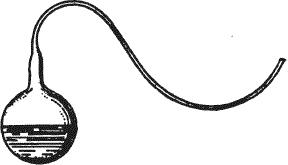
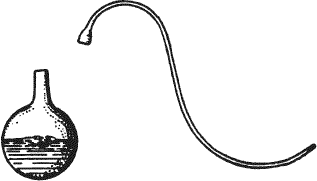
By boiling, I destroyed any germs contained in the liquid or against the glass; but that infusion being again in contact with air it becomes altered, as all infusions do. Now suppose I repeat this experiment, but that, before boiling the liquid, I draw the neck of the flask into a point, leaving, however, its extremity open. This being done, I boil the liquid in the flask, and leave it to cool. Now the liquid of this second flask will remain pure not only two days, a month, a year, but three or four years—for the experiment I am telling you is already four years old, and the liquid remains as limpid as distilled water. - Pasteur at the Sorbonne on April 7, 1864, from The life of PasteurGoogleBook by René Vallery-Radot, translated by R. L. Devonshire, 1906
Pasteur's discovery of the bacterial action in the production of wines and vinegars had also practical consequences. Industrial methods in the production of wines and vinegar were greatly improved and the concept of pasteurization, the protection against microbes by the action of heat, then introduced. What remains distinctive is Pasteur's classical demonstration of the action of oxygen on wine.
Effect of oxygen on red wine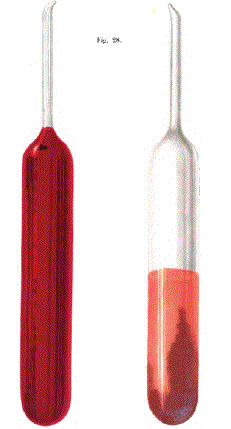
Might not the diseases of wines be caused by organized ferments, microscopic vegetations, of which the germs would develop when certain circumstances of temperature, of atmospheric variations, of exposure to air, would favor their evolution or their introduction into wines? - Pasteur at the Académie des Sciences in January 1864, from The life of PasteurGoogleBook by René Vallery-Radot, translated by R. L. Devonshire, 1906
In 1865, Pasteur's destiny shifted towards a new course when he accepted to study the disease of silkworms to which he devoted six years. He discovered that diseases may result from the development of a microbe in healthy tissues of its host. Pasteur's orientation towards pathology would ultimately lead him to make a connection between contagion and heredity. By studying the contagious diseases of silkworms he addressed for the first time the question of 'receptivity to germs'. He was on the path leading towards immortal fame.
The consecutive study - the manufacture of beers - was started by Pasteur with the motivation of raising the quality of French beers to German standards. Ultimately, Pasteur's book on brewing will reflect the fact his mind was at that time preoccupied by questions more crucial to him than the problems of the French brewers. The specificity of his germ theory had been attacked by the partisans of the transformation of microscopic species. The notion of spontaneous generation of yeast was resurfacing. It is one more time by experimentation that Pasteur demonstrated that a microscopic species does not transform into another thereby establishing the specificity of microbial diseases. Furthermore he described the adaptation of microscopic species to aerobic or anaerobic conditions giving birth to the physiological theory of fermentation.
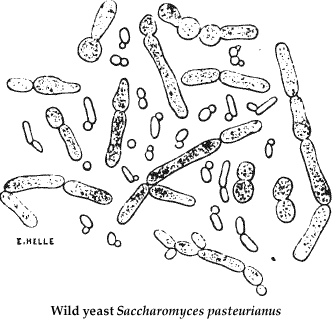
Figure 34 from Etudes sur la bière by Louis Pasteur, 1876
Pasteur had now studied his microbes for twenty years. The general current of ideas about diseases did not support the germ theory, and diseases were generally considered the results of 'forces of the physico-chemical order'. Anthrax, despite Casimir Davaine's pioneer work and Robert Koch's brilliant demonstration of the role of the spore in the etiology of the disease, was still not regarded as a bacterial disease. Pasteur demonstrated unequivocally the bacterial origin of anthrax and by doing so gave the world the magnificent power to 'act on disease'. He further discovered the secretion of bacterial toxins and their action in the host, the strict anaerobic character of the 'septic vibrio' and its role as agent in septicemia, and also general conditions for the establishment of specific bacterial diseases. During his time, Pasteur forcibly imposed the sterile surgical practices already followed by Joseph Lister in England.

Vaccinating sheep for anthrax, from the 1926 edition of Paul de Kruif's Microbe Hunters
In his final studies, Pasteur developed vaccines for chicken cholera, anthrax and rabies. As he gained public confidence his popularity increased thereby allowing the creation of the Pasteur Institute. By studying the transmission of bacterial diseases he gave meaning to the notions of attenuation and virulence. He apprehended the concept of natural immunity and finally foresaw the cellular theory of immunity later demonstrated by Elie Metchnikoff with his discovery of the white corpuscles of the blood.
Elie Metchnikoff in his laboratory at the Pasteur Institute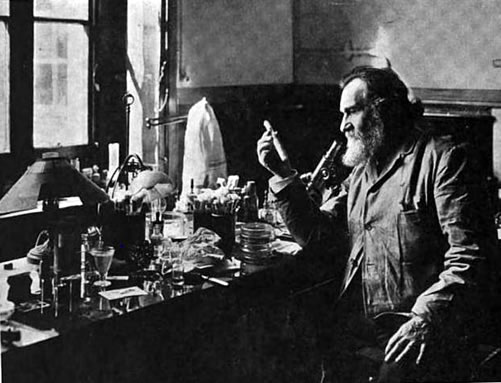
I at once placed myself on your side, He [Pasteur] told me, for I have for many years been struck by the struggle between the divers micro-organisms which I have had occasion to observe. I believe you are on the right road. Excerpt is from Life of Elie Metchnikoff 1845-1916GoogleBook by Olga Metchnikoff, 1921
Louis Pasteur was a savant, a man of the laboratory. His life echoed Alfred Lord Tennyson's poem Ulysses (1842) in his final verse: To strive, to seek, to find, and not to yield.
Miscellanea:Scientific papers by Louis Pasteur, in The Harvard Classics, Volume 38, Part 7
On the antiseptic principle of the practice of surgery by Joseph Lister, 1867, in The Harvard Classics, Volume 38, Part 6
'The Etiology, Concept, and Prophylaxis of Childbed Fever' by Ignaz Semmelweis by P. Pennywagon, 2015
That mothers might live, a 1938 American short drama film directed by Fred Zinnemann. Can it be that on our hands, we are carrying something from operating room straight over to maternity ward, from room to room, from bed to bed, from woman to woman?
Louis Pasteur: his life and laboursGoogleBook by his son-in-law René Vallery-Radot, introduced by John Tyndall, translated by Lady Claud Hamilton, 1885
La vie et l'oeuvre de Pasteur by Jules Bordet, 1905, not translated into English
Note: Jules Bordet (1870-1961) was director of the 'Institut Pasteur du Brabant' from 1900 to 1940, he was awarded the 1919 Nobel Prize in Medicine for his discoveries relating to immunity
The life of PasteurGoogleBook by René Vallery-Radot, translated by R. L. Devonshire, 1906
The Pasteur Institute by François Jacob, 1998, at Nobelprize.org
Afraid of microbes at Library of Congress
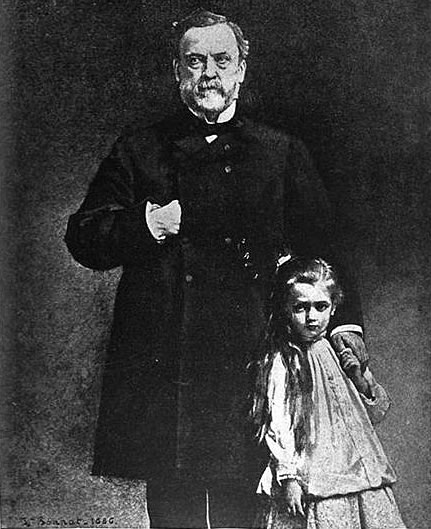
Louis Pasteur and his granddaughter Camille, Engraving from a painting by Léon Bonnat (1833-1922) commissioned in 1886 by brewer Jacobsen for Mme Pasteur, Original: Musée Pasteur, Pasteur Institute
Grande symphonie funèbre et triomphale by Hector Berlioz, 1840, performed by London Symphony Orchestra & Chorus conducted by Sir Colin Davis
Minst.org Online Library Index